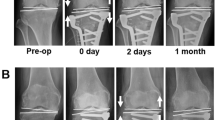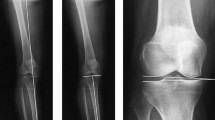Abstract
Introduction
The purpose of this study was to assess early postoperative loss of achieved correction and associated factors after opening wedge high tibial osteotomy (OWHTO).
Materials and methods
OWHTO was performed in 121 patients with osteoarthritis of the knee (mean age 66 years, 154 knees). Anteroposterior radiographs of the knee and full-length leg, and varus and valgus stress radiographs of the knee were taken, and the femorotibial angle (FTA), joint line convergence angle (JLCA), and medial proximal tibial angle (MPTA) were measured. The changes in the FTA, JLCA, and MPTA were defined as ΔFTA, ΔJLCA, and ΔMPTA.
Results
The ΔFTA and ΔJLCA at postoperative 0–2 days were − 1.8 ± 1.2° and − 1.9 ± 1.4°, respectively. The ΔFTA, ΔJLCA and ΔMPTA at postoperative 1–12 months were 0.9 ± 1.3°, 0.2 ± 1.2° and − 0.8 ± 0.8°, respectively. A positive correlation was found between ΔFTA and ΔJLCA at postoperative 0–2 days (ρ = 0.642, P < 0.001) and at postoperative 1–12 months (ρ = 0.402, P < 0.001). A negative correlation was found between ΔFTA and ΔMPTA at postoperative 1–12 months (ρ = − 0.534, P < 0.001). A discrepancy in alignment represented by the FTA occurred in the supine radiographs between the day of surgery and postoperative 2 days. Multiple regression analysis suggested that postoperative JLCA on the day of surgery was the factor related to early postoperative change of the FTA.
Conclusions
This study demonstrated the early loss of achieved correction after OWHTO due to change of the JLCA, even if the accurate alignment is obtained intraoperatively.

Similar content being viewed by others
References
Agneskirchner JD, Hurschler C, Wrann CD et al (2007) The effects of valgus medial opening wedge high tibial osteotomy on articular cartilage pressure of the knee: a biomechanical study. Arthroscopy 23(8):852–861
Elson DW, Petheram TG, Dawson MJ (2015) High reliability in digital planning of medial opening wedge high tibial osteotomy, using Miniaci's method. Knee Surg Sports Traumatol Arthrosc 23(7):2041–2048
Han JH, Kim HJ, Song JG et al (2017) Locking plate versus non-locking plate in open-wedge high tibial osteotomy: a meta-analysis. Knee Surg Sports Traumatol Arthrosc 25(3):808–816
Hernigou P, Medevielle D, Debeyre J et al (1987) Proximal tibial osteotomy for osteoarthritis with varus deformity. A ten to thirteen-year follow-up study. J Bone Joint Surg Am 69(3):332–354
Jang YW, Lim D, Seo H et al (2018) Role of an anatomically contoured plate and metal block for balanced stability between the implant and lateral hinge in open-wedge high-tibial osteotomy. Arch Orthop Trauma Surg 138(7):911–920
Jin C, Song EK, Santoso A et al (2019) Survival and risk factor analysis of medial open wedge high tibial osteotomy for unicompartment knee osteoarthritis. Arthroscopy
Jung WH, Chun CW, Lee JH et al (2013) Comparative study of medial opening-wedge high tibial osteotomy using 2 different implants. Arthroscopy 29(6):1063–1071
Koshino T, Yoshida T, Ara Y et al (2004) Fifteen to twenty-eight years' follow-up results of high tibial valgus osteotomy for osteoarthritic knee. Knee 11(6):439–444
Lee DH, Nha KW, Park SJ et al (2012) Preoperative and postoperative comparisons of navigation and radiologic limb alignment measurements after high tibial osteotomy. Arthroscopy 28(12):1842–1850
Lee DH, Park SC, Park HJ et al (2016) Effect of soft tissue laxity of the knee joint on limb alignment correction in open-wedge high tibial osteotomy. Knee Surg Sports Traumatol Arthrosc 24(12):3704–3712
Lee DK, Wang JH, Won Y et al (2019) Preoperative latent medial laxity and correction angle are crucial factors for overcorrection in medial open-wedge high tibial osteotomy. Knee Surg Sports Traumatol Arthrosc
Ogata K, Yoshii I, Kawamura H et al (1991) Standing radiographs cannot determine the correction in high tibial osteotomy. J Bone Jt Surg Br 73(6):927–931
Ogawa H, Matsumoto K, Akiyama H (2018) New angle measurement device to control the posterior tibial slope angle in medial opening wedge high tibial osteotomy. Arch Orthop Trauma Surg 138(3):299–305
Ogawa H, Matsumoto K, Ogawa T et al (2016) Preoperative varus laxity correlates with overcorrection in medial opening wedge high tibial osteotomy. Arch Orthop Trauma Surg 136(10):1337–1342
Okamoto S, Okazaki K, Mitsuyasu H et al (2013) Lateral soft tissue laxity increases but medial laxity does not contract with varus deformity in total knee arthroplasty. Clin Orthop Relat Res 471(4):1334–1342
Paley D (2003) Malalignment and malorientation in the frontal plane. In: Paley D, Herzenberg JE (eds) Principles of deformity correction. Springer, New York, pp 19–30
Purevsuren T, Khuyagbaatar B, Kim K et al (2019) Effects of medial collateral ligament release, limb correction, and soft tissue laxity on knee joint contact force distribution after medial opening wedge high tibial osteotomy: a computational study. Comput Methods Biomech Biomed Engin 22(3):243–250
Ribeiro CH, Mod MSB, Isch D et al (2020) A novel device for greater precision and safety in open-wedge high tibial osteotomy: cadaveric study. Arch Orthop Trauma Surg 140(2):203–208
Saito T, Kumagai K, Akamatsu Y et al (2014) Five- to ten-year outcome following medial opening-wedge high tibial osteotomy with rigid plate fixation in combination with an artificial bone substitute. Bone Jt J 96(3):339–344
Sasanuma H, Sekiya H, Takatoku K et al (2010) Evaluation of soft-tissue balance during total knee arthroplasty. J Orthop Surg (Hong Kong) 18(1):26–30
Sato D, Kondo E, Yabuuchi K et al (2019) Assessment of valgus laxity after release of the medial structure in medial open-wedge high tibial osteotomy: an in vivo biomechanical study using quantitative valgus stress radiography. BMC Musculoskelet Disord 20(1):481
Sekiya H, Takatoku K, Takada H et al (2009) Postoperative lateral ligamentous laxity diminishes with time after TKA in the varus knee. Clin Orthop Relat Res 467(6):1582–1586
Seo SS, Kim CW, Seo JH et al (2016) Does superficial medial collateral ligament release in open-wedge high tibial osteotomy for varus osteoarthritic knees increase valgus laxity? Am J Sports Med 44(4):908–915
Tsukeoka T, Tsuneizumi Y (2016) Varus and valgus stress tests after total knee arthroplasty with and without anesthesia. Arch Orthop Trauma Surg 136(3):407–411
Tsukeoka T, Tsuneizumi Y (2019) Residual medial tightness in extension is corrected spontaneously after total knee arthroplasty in varus knees. Knee Surg Sports Traumatol Arthrosc 27(3):692–697
Funding
There is no funding source.
Author information
Authors and Affiliations
Corresponding author
Ethics declarations
Conflict of interest
The authors declare that they have no conflict of interest.
Ethical approval
The study was approved by the institutional review board.
Informed consent
Informed consent was obtained from all individual participants included in the study.
Additional information
Publisher's Note
Springer Nature remains neutral with regard to jurisdictional claims in published maps and institutional affiliations.
Rights and permissions
About this article
Cite this article
Kumagai, K., Yamada, S., Akamatsu, T. et al. Intraoperatively accurate limb alignment after opening wedge high tibial osteotomy can be lost by large knee joint line convergence angle during surgery. Arch Orthop Trauma Surg 141, 23–28 (2021). https://doi.org/10.1007/s00402-020-03419-1
Received:
Published:
Issue Date:
DOI: https://doi.org/10.1007/s00402-020-03419-1




